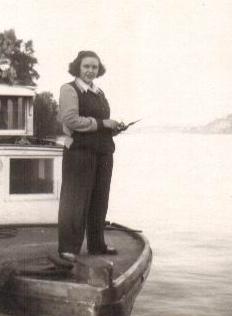
Virginia May Brown was born September 25th, 1918, the youngest of 3. Her brothers were much older than she--nine years separated her from Delmar, the younger of the two--but they loved her dearly and were very protective of their baby sister. Her parents were well-educated descendants of Oregon pioneers and were active in the small town of Silverton, founding the telephone and water companies and her father at one time serving as mayor. Their house was bordered by Silver Creek; her childhood memories were full of days playing in and beside the water with her friends.
She went to the University of Oregon in 1939 and majored in drafting and interior design. At the time, women were a rare presence in the sciences. Ginny was the only woman in the School of Architecture during her studies and had to endure the taunts of her fellow classmates. But others supported and defended her, for she held her own. She graduated with her Bachelor of Sciences in 1944.
At the time, the US was deep in World War II and the need for draftsmen in the shipyards was great. Ginny obtained a job as a draftsman with Kaiser Steel in Portland after her graduation and worked on the Liberty Ships being built on Swan Island. At the same time, she held a job at Baker Lighting translating the artist designs into working blueprints for the craftsmen.
In the evening, she would go dancing with her friends in downtown Portland. One of those gatherings happened at the Press Club, where she was introduced to an advertising space salesman named Earle Stephens. He was ebullient and friendly, but Ginny was shy and careful. Her girlfriends convinced her that he was a gentleman and insisted she dance with him. It was the beginning of their courtship. They married March 2nd, 1945.
When they married, Earle insisted that Ginny didn't work, but it didn't mean Ginny wasn't going to let him make all the decisions about the money. The sale of the family-owned Silverton telephone company left her with money that she then put into a trust that Earle had no say on. Ginny had learned business from her parents and brothers so was not intimidated with dealing with contractors, bankers, or lawyers. It was with dividends from that trust that she was able to provide the extras that made the Stephens house comfortable and later provide funds to have the kitchen remodeled, provide loans to her children for house purchases, and help in sending her youngest to college.
Ginny loved art from her childhood on. She wanted to use her artistic talent to provide a career; later it gave her an outlet from the ennui of being a housewife. She learned rosemaling and went to painting class every Wednesday where she said she and her friends "solved the world's problems" while creating intricately designed pieces. She would make up her own designs for items she found at garage and estate sales and antique shops, stripping the item of its original label or paint and repainting them with Norwegian designs, flowers, and scrollwork. She also drew with colored pencils, experimented with water colors, and sketched the flowers that she lovingly grew in her garden.
Family necessity drew her to learning fine sewing and tailoring, making the clothing for her children and husband so that they would look decent. She also knitted, though not as much as she sewed. She didn't limit herself to making clothes for her children; her daughter Shirley's Barbie dolls had a fine wardrobe of stylish clothes as well, made from the leftovers. When clothes wore out, they were recycled. Braided rugs were on the floors, made up from old coats, suits, and blankets. The only thing she didn't do with fabric was quilt.
Ginny never spoke of regretting her choice to not work in her chosen career after marriage. There were days when she spoke of wanting to have gone to Europe or being free of the burdens she had been given. But she loved Earle very much and loved her family, even though she liked to have her children entertain themselves as much as possible and leave her to her pleasures. In her last year, she found herself free to do what she pleased in her own home and reveled in it, experimenting with different techniques and media.
She died of cancer March 16th, 1988, six days after Earle died of a stroke in his sleep. She left behind her painted plates and boxes, pictures of teasel, camellia, and hosta, and cabled afghans. She also left memories of a woman who treasured beauty around her.
This Mother's Day, I remember my mom as I knew her. I may be erroneous in my writing, but this is how I see her. She and I grew very close in her later years. She would be 88 this year if she was still around. I miss her, but I know her spirit is with me. Because of her, I do what I do.
1 comment:
What a lovely tribute to your mother. She sounds like a magnificent woman.
Post a Comment